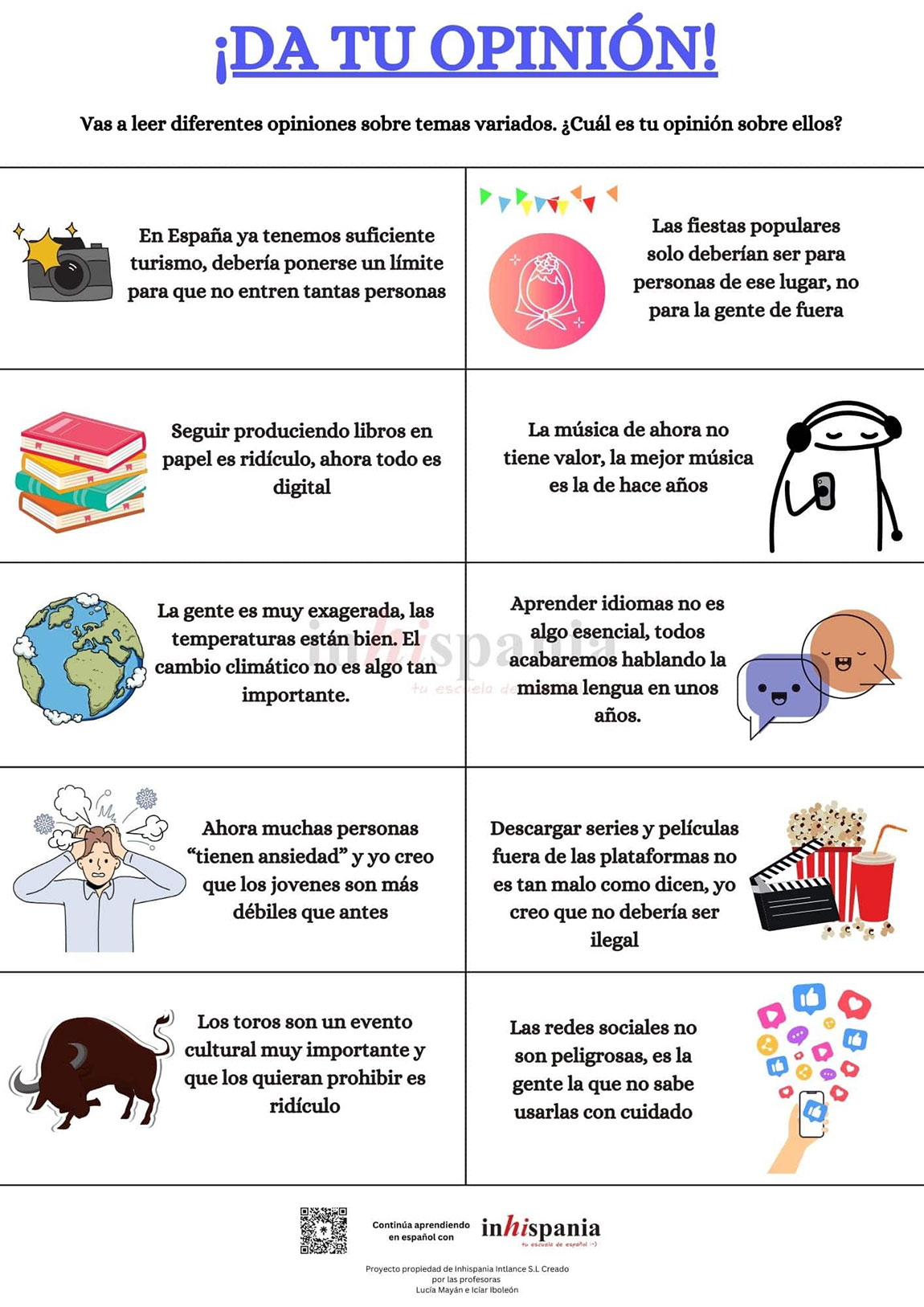Teaching Spanish as a Foreign Language (ELE) students to express their opinions effectively is fundamental for their linguistic and communicative development. This skill not only allows them to participate in everyday conversations, but also helps them develop the ability to argue and debate a variety of topics. At intermediate levels like B1, it is especially crucial, as students must be able to communicate their points of view clearly and participate in simple debates on familiar topics. As students progress, they will learn to nuance their opinions, justify them with solid arguments, and handle both agreement and disagreement in a respectful and effective way. This process fosters confidence in their language skills and prepares them to interact more fluently in real-world contexts.
Developing critical competence is equally important, as it allows students to analyze, evaluate, and construct well-founded arguments. This skill helps them interpret and question information more deeply, contributing to more reflective and autonomous thinking. The ability to formulate and defend opinions critically is essential not only in language learning but also in their daily and professional lives.
Below, we present a detailed guide with resources and strategies organized by level to help you integrate opinion expression into your classes in a dynamic and effective way.
Basic Level A1-A2: Introduction to Expressing Opinions
1. Basic Vocabulary and Common Phrases
For beginner levels, start with simple structures so students can begin expressing their opinions. Some useful phrases include:
- “I think that…”
- “I believe that…”
- “In my opinion…”
- “For me…”
- “It seems to me that…”
- “In my view…”
Example Activity: “My Opinion About…”
For this activity, ask students to choose a simple and personal topic, such as their favorite food, a movie they like, or a hobby. The goal is for them to use the phrases they have learned to express their opinions about the chosen topic. Provide images related to the selected topics to facilitate the task and stimulate vocabulary. For example, show photos of different foods or movie posters for students to choose and talk about. This activity not only helps them practice opinion structures in a familiar and comfortable context but also encourages interaction and the exchange of ideas in class. Make sure students share their opinions in pairs or small groups to maximize oral practice and provide constructive feedback.
Resource: Use Quizlet to create flashcards with these phrases and related vocabulary.
Intermediate Level B1: Justification and Argumentation
2. Expressing Opinions with Justification
At intermediate levels, teach students to justify and argue their opinions. Introduce phrases such as:
- “Because…”
- “Since…”
- “Due to the fact that…”
- “For this reason…”
Example Activity: “Mini Debate”
For this activity, organize a class debate on a familiar and relevant topic, such as “Is it better to live in the city or in the countryside?” Divide students into two groups, assigning each a position in the debate. Encourage students to use the phrases they have learned to express and justify their points of view. For example, they can use expressions like “I think that…”, “Because…”, and “Due to the fact that…” to argue for living in the city or the countryside.
During the debate, students should present their arguments, respond to the other group’s objections, and try to persuade their classmates. This activity not only helps practice expressing opinions and argumentation but also fosters active listening skills and respect for different points of view. At the end, you can have a group reflection on the strategies used and the skills developed during the debate.
Resource: Use this infographic showing different topics with points of view and arguments for and against.
https://es.pinterest.com/pin/934285885188304561/

Advanced Level B1-B2: Expressing Agreement and Disagreement
3. Nuanced and Critical Expression
For advanced levels, work with more sophisticated expressions that allow for critical interaction:
- “I agree with…”
- “You’re right about…”
- “I don’t agree with…”
- “I don’t think that’s correct because…”
Suggested Activity: “Group Discussion”
To carry out this activity, divide students into small groups and provide them with controversial statements to debate. For example, you can use current and controversial topics such as “Should governments impose higher taxes on large corporations?” or “Is it necessary to restrict the use of plastics to protect the environment?”
Instructions:
- Group Formation: Divide students into groups of 3-4. Assign each group a controversial statement to debate.
- Preparation: Before the debate, each group should research their statement using opinion articles from Spanish newspapers to have a solid base. You can use sources like:
- ABC: https://www.abc.es/opinion/
- El País: https://elpais.com/opinion/
- El Mundo: https://www.elmundo.es/opinion.html
- Debate: During the debate, establish turns, possibly with a moderator, and encourage respectful and critical dialogue.
- Reflection: After the debate, organize a group reflection where each team shares their conclusions and discusses the strategies they used to argue and respond to objections.
This activity also allows students to contrast the editorial and ideological lines of different Spanish newspapers, adding extra cultural content to the class.
Integrating Communicative Competence
To maximize learning and allow students to apply their skills in real contexts, integrate the following activities:
- Role Plays: Organize simulations in which students play different characters or situations, thus practicing the expression of opinions in varied contexts.
- Oral Presentations: Encourage students to prepare and present topics of their choice. During these presentations, they should express their opinions, justify them appropriately, and answer classmates’ questions.
- Discussion of Proposed Topics: Allow students to propose and debate topics that interest them. This not only increases their engagement with the activity but also ensures that debates are relevant and meaningful.
- Final Task Suggestion: As a final task, ask students to prepare a presentation on a topic of their choice. They should express and justify their opinion and respond to classmates’ questions, using the structures and skills practiced in class.
The Importance of Open and Respectful Dialogue
Promoting open and respectful dialogue helps ensure that all participants feel valued and heard. By establishing clear rules for respect and empathy, effective communication is facilitated, and the learning process is enriched, allowing students to share their opinions and experiences constructively and without fear of offending or being offended. This is especially relevant in learning contexts with diverse groups, such as our Spanish school in Madrid, which includes students of different nationalities and cultures, where it is crucial to foster an environment of mutual respect and understanding. It is important to avoid topics that may lead to conflict or misunderstandings, as cultural differences and individual sensitivities can influence how certain issues are perceived and interpreted.
We hope these resources and strategies help you enrich your classes and strengthen your students’ linguistic resources and opinion expression skills!



